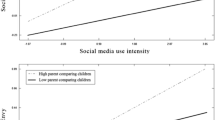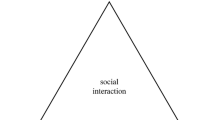Abstract
This study investigates avatars’ gender and age differences in their help-seeking interactions in virtual worlds. Specifically, we conducted data collections from two popular help-supporting regions from Second Life, and performed two levels of analyses. We first examined the existence of the overall gender and age differences, and then compared and tested the detailed differences by creating three types of interaction networks based on avatar gender and avatar age, respectively. Overall, we found that the interaction networks of the same gender tended to be more centralized than the interaction networks with mixed genders. In addition, the interaction networks of the same age group tended to be more centralized than the interaction networks with mixed ages. We also found that old-aged avatars had significantly higher values than young-aged avatars in all measurement dimensions, indicating that old-aged avatars played more important roles in help-seeking interactions.

Similar content being viewed by others
References
Antonucci, T. C., & Akiyama, H. (1987). An examination of sex differences in social support among older men and women. Sex Roles, 77(11/12), 737–749.
Bainbridge, W. S. (2007). The scientific research potential of virtual worlds. Science, 317, 472–476.
Biddle, B. J. (1986). Recent development in role theory. Annual Review of Sociology, 1267–1292.
Blascovich, J., Loomis, J., Beall, A. C., Swinth, K. R., Hoyt, C. L., & Bailenson, J. N. (2002). Immersive virtual environment technology as a methodological tool for social psychology. Psychological Inquiry, 13(2), 103–124.
Bououd, I., Rouis, S., Skandrani, Boughzala, I., & Makhlouf, M. (2016). Impact of object manipulation, customization and social loafing on competencies management in 3D virtual worlds. Information Systems Frontiers, 18(6), 1191–1203.
Bowling, A. (1991). Social support and social networks: Their relationship to the successful and unsuccessful survival of elderly people in the community. An analysis of concepts and a review of the evidence. Journal of Family Practice, 8(1), 68–83.
Brebner, J. (2003). Gender and emotions. Personality and Individual Differences, 34, 387–394.
Brin, S., & Page, L. (1998). The anatomy of a large-scale hypertextual web search engine. Computer Networks and ISDN Systems, 30(1–7), 107–117.
Briton, N. J., & Hall, J. A. (1995). Gender-based expectancies and observer judgments of smiling. Journal of Nonverbal Behavior, 19, 49–65.
Brody, L. R. (1985). Gender differences in emotional development: A review of theories and research. Journal of Personality, 53(2), 102–149.
Brody, L. R. (1997). Gender and emotion: Beyond stereotypes. Journal of Social Issues, 53(2), 369–394.
Brody, L. R., & Hall, J. (1993). Gender and emotion. In M. Lewis & J. Haviland (Eds.), Handbook of emotions (pp. 447–461). New York: Guilford Press.
Brody, L., & Hall, J. (2008). Gender and emotion in context. In M. Lewis, J. Haviland-Jones, & L. F. Barrett (Eds.), Handbook of emotions (3 ed) (pp. 395–408). New York: The Guildford Press.
Bryant, M. (2015). Think Second Life died? It has a higher GDP than some countries. https://thenextweb.com/insider/2015/2011/2007/think-second-life-died-it-has-a-higher-gdp-than-some-countries/#.tnw_QEeGVLpu. Accessed 2029 April 2017 .
Chaturvedi, A. R., Dolk, D. R., & Drnevich, P. L. (2011). Design principles for virtual worlds. MIS Quarterly, 35(3 September), 673–684.
Chau, M., & Xu, J. (2012). Business intelligence in blogs: Understanding consumer interactions and communities. MIS Quarterly, 36(4), 1189–1216.
Diversified Media Design, Combinedstory, & Market Truths Limited (2007). The virtual brand footprint: The marketing opportunity in second life. Accessed 7 Jan 2012.
Eagly, A. H. (1987). Sex differences in social behavior: A social role interpretation. Hillsdale: Erlbaum.
Eagly, A., & Karau, S. (1991). Gender and the emergence of leaders: A meta-analysis. Journal of Personality and Social Psychology, 60(5), 685–710.
Eagly, A. H., & Wood, W. (1991). Explaining sex differences in social behavior: A meta-analytic perspective. Personality and Social Psychology Bulletin, 17, 306–315.
Fabes, R. A., & Martin, C. L. (1991). Gender and age stereotypes of emotionality. Personality and Social Psychology Bulletin, 17, 532–540.
Fischer, A. H., & Manstead, A. S. R. (2004). Gender and culture differences in emotion. Emotion, 4(1), 87–94.
Fiske, S., & Stevens, L. (1993). What's so special about sex? Gender stereotyping and discrimination. In S. Oskamp & M. Costanzo (Eds.), Gender issues in contemporary society (pp. 173–196). Newbury Park: Sage Publications.
Freeman, L. (1977). A set of measures of centrality based on betweenness. Sociometry, 40, 35–41.
Freeman, L. (1979). Centrality in social networks: Conceptual clarification. Social Networks, 1, 215–239.
Gordon, R., Björklund, N. K., Smith, R. J., & Blyden, E. R. (2009). Halting HIV/AIDS with avatars and Havatars: A virtual world approach to modelling epidemics. BMC Public Health, 9(S13), 1–6.
Grinstein-Weiss, M., Fishman, G., & Eisikovits, Z. (2005). Gender and ethnic differences in formal and informal help seeking among Israeli adolescents. Journal of Adolescence, 28(6), 765–779.
Grossman, M., & Wood, W. (1993). Sex differences in the intensity of emotional experience: A social role interpretation. Journal of Personality and Social Psychology, 65, 1010–1022.
Harris, H., Bailenson, J. N., Nielsen, A., & Yee, N. (2009). The evolution of social behavior over time in second life. Presence: Teleoperators and Virtual Environments, 18(6), 434–448.
Hendaoui, A., Limayem, M., & Thompson, C. W. (2008). 3D social virtual worlds: Research issues and challenges. IEEE Internet Computing, 12(1), 88–92.
Hu, D., Zhao, J. L., Hua, Z., & Wong, M. C. S. (2012). Network-based modeling and analysis of systemic risk in banking systems. MIS Quarterly, 36(4), 1269–1291.
Jackson, L. A., Ervin, K. S., Gardner, P. D., & Schmitt, N. (2001). Gender and the internet: Women communicating and men searching. Sex Roles: A Journal of Research, 44(5–6), 363–378.
Jansz, J. (2000). Masculine identity and restrictive emotionality. In A. H. Fischer (Ed.), Gender and emotion: Social psychological perspectives (pp. 166–188). Cambridge: Cambridge University Press.
Kawale, J., Pal, A., & Srivastava, J. (2009). Churn Prediction in MMORPGs: A Social Influence Based Approach. In Proceedings of the IEEE International conference on Computational Sciences and Engineering, (pp. 423–428): IEEE Computer Society.
Keegan, B., Ahmad, M., Srivastava, J., Williams, D., & Contractor, N. (2010). Dark Gold: Statistical properties of clandestine networks in massively multiplayer online games. In Proceedings of IEEE 2nd international conference Social Computing, (pp. 201–208): IEEE Computer Society.
Kleinberg, J. M. (1999). Authoritative sources in a hyperlinked environment. Journal of the ACM, 46(5), 604–632.
Landman-Peeters, K. M. C., Hartman, C. A., Pompe, G. v. d., Boer, J. A. d., Minderaa, R. B., & Ormel, J. (2005). Gender differences in the relation between social support, problems in parent-offspring communication, and depression and anxiety. Social Science & Medicine, 60(11), 2549–2559.
Laniado, D., Volkovich, Y., Scellato, S., Mascolo, C., & Kaltenbrunner, A. (2017). The impact of geographic distance on online social interactions. Information Systems Frontiers. https://doi.org/10.1007/s10796-017-9784-9.
Lin, X., Featherman, M., Brooks, S. L., & Hajli, N. (2018). Exploring gender differences in online consumer purchase decision making: An online product presentation perspective. Information Systems Frontiers. https://doi.org/10.1007/s10796-018-9831-1.
Malcom, N. (2003). Constructing female athleticism: A study of Girls' recreational softball. American Behavioral Scientist, 46(10), 1387–1404.
Melnyk, V., Osselaer, S. M. J. v., & Bijmolt, T. H. A. (2009). Are women more loyal customers than men? Gender differences in loyalty to firms and individual service providers. Journal of Marketing, 73(4), 82–96.
Messinger, P. R., Stroulia, E., Lyons, K., Bone, M., Niu, R. H., Smirnov, K., & Perelgut, S. (2009). Virtual worlds - past, present, and future: New directions in social computing. Decision Support Systems, 47(3), 204–228.
Mihalcea, R.(2004). Graph-based ranking algorithms for sentence extraction, applied to text summarization. In In Proceedings of the 42nd Annual Meeting of the Association for Computational Linguistics (ACL 2004), Barcelona: ACL.
Noble, S. M., Griffith, D. A., & Adjei, M. T. (2006). Drivers of local merchant loyalty: Understanding the influence of gender and shopping motives. Journal of Retailing, 82(3), 177–188.
O'Reilly, T. (2005). What is web 2.0? Design patterns and business models for the next generation of software. Accessed 7 Jan 2012.
Plant, E. A., Hyde, J. S., Keltner, D., & Devine, P. G. (2000). The gender stereotyping of emotions. Psychology of Women Quarterly, 24, 81–92.
Plutchik, R. (1980). A general psychoevolutionary theory of emotion. In R. Plutchik & H. Kellerman (Eds.), Emotion theory, research, and experience (pp. 3–33). New York: Academic Press.
Sears, H. A., Graham, J., & Campbell, A. (2009). Adolescent boys' intentions of seeking help from male friends and female friends. Journal of Applied Developmental Psychology, 30(6), 738–728.
Sharma, G., Qiang, Y., Wenjun, S., & Qi, L. (2013). Communication in virtual world: Second life and business opportunities. Information Systems Frontiers, 15(4), 677–694.
Shields, S. A. (2002). Speaking from the heart: Gender and the social meaning of emotion. Cambridge: Cambridge University Press.
Shim, K. J., Pathak, N., Ahmad, M. A., DeLong, C., Borbora, Z., Mahapatra, A., et al. (2011). Analyzing human behavior from multiplayer online game logs: A knowledge discovery approach. IEEE Intelligent Systems, 26(1), 85–89.
Shye, D., Mullooly, J. P., Freeborn, D. K., & Pope, C. R. (1995). Gender differences in the relationship between social network support and mortality: A longitudinal study of an elderly cohort. Social Science medicine, 41(7), 935–947.
Solberg, S., Choi, K. H., Ritsma, S., & Jolly, A. (1994). Asian American college students: It's time to reach out. Journal of College Student Personnel, 35(4), 296–301.
Stoppard, J. M., & Gunn-Gruchy, C. D. (1993). Gender, context. and expression of positive emotion. Personality and Social Psychology Bulletin, 19(2), 143–150.
Thelwall, M., Wilkinson, D., & Uppal, S. (2010). Data mining emotion in social network communication: Gender differences in MySpace. Journal of the Association for Information Science and Technology (JASIST), 61(1), 190–199.
Tonge, J. (2010). The influence of position and gender on personal networks in a UK professional service. Industrial Marketing Management, 39(3), 390–399.
Varvello, M., & Voelker, G. M. (2010). Second Life: a Social Network of Humans and Bots. In The 20th International Workshop on Network and Operating Systems Support for Digital Audio and Video, Amsterdam, The Netherlands, 2010 (pp. 9–14): ACM.
Vingerhoets, A. J. J. M., Cornelius, R. R., & Van-Heck, G. L. (2000). Adult crying: A model and review of the literature. Review of General Psychology, 4, 354–377.
Wang, W.-T., & Chang, W.-H. (2014). A study of virtual product consumption from the expectancy disconfirmation and symbolic consumption perspectives. Information Systems Frontiers, 16, 887–908.
Wang, Q.-H., Mayer-Schönberger, V., & Yang, X. (2013). The determinants of monetary value of virtual goods: An empirical study for a cross-section of MMORPGs. Information Systems Frontiers, 15, 481–495.
White, S., & Smyth, P. (2003). Algorithms for Estimating Relative Importance in Networks. In Proceedings of the ninth ACM SIGKDD international conference on Knowledge discovery and data mining, Washington D.C., USA, (pp. 266–275): ACM.
Wood, W., & Eagly, A. H. (2002). A cross-cultural analysis of the behavior of women and men: Implications for the origin of sex differences. Psychological Bulletin, 128, 699–727.
Yee, N., & Bailenson, J. N. (2008). A method for longitudinal behavioral data collection in second life. Presence: Teleoperators and Virtual Environments, 17(6), 594–596.
Yee, N., Bailenson, J. N., Urbanek, M., Chang, F., & Merget, D. (2007). The unbearable likeness of being digital: The persistence of nonverbal social norms in online virtual environments. Journal of Cyberpsychology and Behavior, 10, 115–121.
Yeh, C. J. (2002). Taiwanese Students' gender, age, interdependent and independent self-construal, and collective self-esteem as predictors of professional psychological help-seeking attitudes. Cultural Diversity and Ethnic Minority Psychology, 8(1), 19–29.
Zammuner, V. L. (2000). Men's and women's lay theories of emotion. In A. Fischer (Ed.), Gender and emotion: Social psychological perspectives (pp. 48–70). Cambridge: Cambridge University Press.
Zhang, Y., Yu, X., Dang, Y., & Chen, H. (2010). An integrated framework for avatar data collection from the virtual world. IEEE Intelligent Systems, 25(6), 17–23.
Author information
Authors and Affiliations
Corresponding author
Additional information
Publisher’s Note
Springer Nature remains neutral with regard to jurisdictional claims in published maps and institutional affiliations.
Rights and permissions
About this article
Cite this article
Zhang, Y.G., Dang, M.Y. & Chen, H. An Explorative Study on the Virtual World: Investigating the Avatar Gender and Avatar Age Differences in their Social Interactions for Help-Seeking. Inf Syst Front 22, 911–925 (2020). https://doi.org/10.1007/s10796-019-09904-2
Published:
Issue Date:
DOI: https://doi.org/10.1007/s10796-019-09904-2




